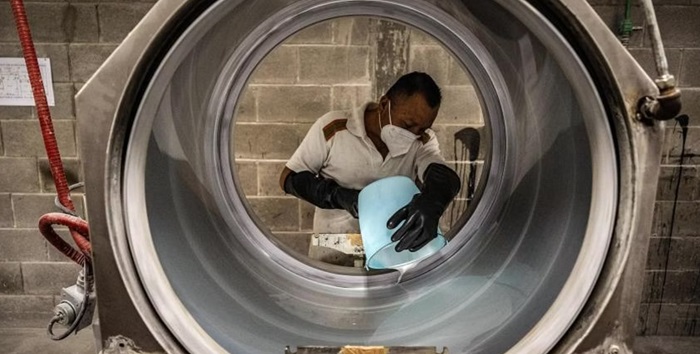
In the depths of the pandemic, as global supply chains buckled and the cost of shipping a container to China soared nearly twentyfold, Mr Marco Villarreal spied an opportunity.
In 2021, Mr Villarreal resigned as Caterpillar’s director-general in Mexico and began nurturing ties with companies looking to shift manufacturing from China to Mexico. He found a client in Hisun, a Chinese producer of all-terrain vehicles, which hired him to establish a $152 million (S$204.6 million) manufacturing site in Saltillo, an industrial hub in northern Mexico.
Mr Villarreal said foreign companies, particularly those seeking to sell within North America, saw Mexico as a viable alternative to China for several reasons, including the simmering trade tensions between the United States and China.
“The stars are aligning for Mexico,” he said.
New data released on Feb 7 showed that Mexico outpaced China for the first time in 20 years to become the United States’ top source of official imports – a significant shift that highlights how increased tensions between Washington and Beijing are altering trade flows.
The US’ trade deficit with China narrowed significantly last year, with imports from the country dropping 20 per cent to US$427.2 billion, the data shows. American consumers and businesses turned to Mexico, Europe, South Korea, India, Canada and Vietnam for auto parts, shoes, toys and raw materials.
Mexican exports to the US were roughly the same as in 2022, at US$475.6 billion.
The US’ total trade deficit in goods and services, which consists of exports minus imports, narrowed 18.7 per cent. Overall US exports to the world increased slightly in 2023 from the previous year, despite a strong dollar and a soft global economy.
US imports fell annually as Americans bought less crude oil and chemicals and fewer consumer goods, including cellphones, clothes, camping gear, toys and furniture.
The recent weakness in imports, and drop-off in trade with China, has partly been a reflection of the pandemic. American consumers stuck at home during the pandemic snapped up Chinese-made laptops, toys, Covid-19 tests, athleisure, furniture and home exercise equipment.
Even as concerns about the coronavirus faded in 2022, the United States continued to import a lot of Chinese products, as bottlenecks at congested US ports finally cleared and businesses restocked their warehouses.
“The world couldn’t get access to enough Chinese goods in ’21, and it gorged on Chinese goods in ’22,” said Dr Brad Setser, an economist and senior fellow at the Council on Foreign Relations. “Everything has been normalizing since then.”
But beyond the unusual swings in annual patterns in the last few years, trade data is beginning to provide compelling evidence that years of heightened tensions have significantly chipped away at the US’ trading relationship with China.
In 2023, US quarterly imports from China were at roughly the same level as they were 10 years ago, despite a decade of growth in the US economy and rising US imports from elsewhere in the world.
“We are decoupling, and that’s weighing heavily on trade flows,” Moody’s Analytics chief economist Mark Zandi said of the US and China.
Economists say the relative decrease in trade with China is clearly linked to the tariffs imposed by the Trump administration and then maintained by the Biden administration.
Research by Dr Caroline Freund, the dean of the School of Global Policy and Strategy at the University of California, San Diego, showed that trade with China fell for products that have high tariffs, such as screwdrivers and smoke detectors, while trade in products that do not have tariffs, such as hair dryers and microwave ovens, continued to grow.
Professor Ralph Ossa, the chief economist for the World Trade Organisation, said trade between the US and China had not collapsed, but that it had been growing about 30 per cent more slowly than trade between those countries and the rest of the world.
There were two episodes in recent history where US trade with China slowed notably, he said. The first was when trade tensions between the countries escalated in 2018. The second was when Russia invaded Ukraine, prompting the US and its allies to impose strict sanctions and further reshuffling global trade relationships.
“There was a period where geopolitics didn’t really matter for trade much, but as uncertainty increases in the world, we do see that trade becomes more sensitive to these positions,” said World Trade Organisation a research economist Stela Rubinova.
Some economists caution that the US reduction in trade with China might not be as sharp as bilateral data shows. That is because like Hisun, the Chinese vehicle producer, some multinationals have shifted portions of their manufacturing out of China and into other countries but continued sourcing some raw materials and parts from China.
In other cases, companies may simply be routing goods that are actually made in China through other countries to avoid US tariffs.
US trade statistics do not record such products as coming from China, even though a significant portion of their value would have been created there.
Dr Freund, who wrote a recent paper on the subject, said the two countries’ trade relationship was “definitely being attenuated, but not as much as the official statistics suggest.”
Still, geopolitical risks are clearly pushing companies to look to other markets, particularly those with low costs and stable trading relationships with the US, such as Mexico.
Mr Jesús Carmona, the president for Mexico and Central America at Schneider Electric, the French electrical equipment giant, said the Biden administration’s 2022 climate law and geopolitical tensions stemming from the war in Ukraine were both factors pushing companies toward Mexico.
When China appeared to align with Russia in the conflict, “it triggered all sorts of alarms,” Mr Carmona said. “People realised we cannot have such dependencies on China, which we built up over the last 40 years as we were making China the factory of the world.”
Schneider, which already had a substantial presence in Mexico with nine factories and nearly 12,000 employees, decided in 2021 that it needed to grow further in the country. Now, after opening new manufacturing sites and expanding existing plants, the company has about 16,000 employees in Mexico, with plans for that number to soon reach about 20,000.
Schneider sends about 75 per cent to 80 per cent of its production in Mexico to the US, including an array of products such as circuit breakers and panels used to distribute and regulate electrical power.
While foreign direct investment in developing countries fell 9 per cent in 2023, the flow of such investment to Mexico surged 21 per cent last year, according to the United Nations Conference on Trade and Development.
Another economy caught in the shifting tides between the US and China has been South Korea. Like Mexico, South Korea is subject to lower tariffs because it has a free trade deal with the US. In December, US imports from South Korea were the highest on record.
South Korean firms have also particularly benefited from President Joe Biden’s new climate legislation. The US government is offering tax credits for consumers who buy electric vehicles, but it has set certain limits on sourcing parts of those cars from China.
As major manufacturers of electric vehicle batteries and components, South Korean firms have seized the opportunity to participate in newly expanding US vehicle supply chains. One Korean battery manufacturer, SK On, has invested US$2.6 billion in a factory in Georgia and is building new facilities in Georgia, Tennessee and Kentucky in partnership with Hyundai and Ford.
Mr Min Sung, the chief commercial officer of SK On, said China was getting more restrictive for Korean businesses. Meanwhile, the US constraints on China benefiting from electric vehicle tax credits had given Korean businesses “more space to play”.
“In order for business to survive, you always find the market that’s got more potential,” Mr Sung said.
As major South Korean companies such as SK, LG, Samsung and Hyundai build new facilities to make products in the US, that also appears to be increasing US trade with South Korea since companies are importing some materials, machinery and parts from their home countries to supply the new facilities.
In December, Korean exports to the US surpassed Korean exports to China for the first time in 20 years, driven by shipments of vehicles, electric batteries and other parts.
Mr Sung agreed that increasing American scepticism of China was pushing the United States and South Korea closer together.
“It’s never been stronger than the last couple of years between two allies,” he said. (NY Times)

